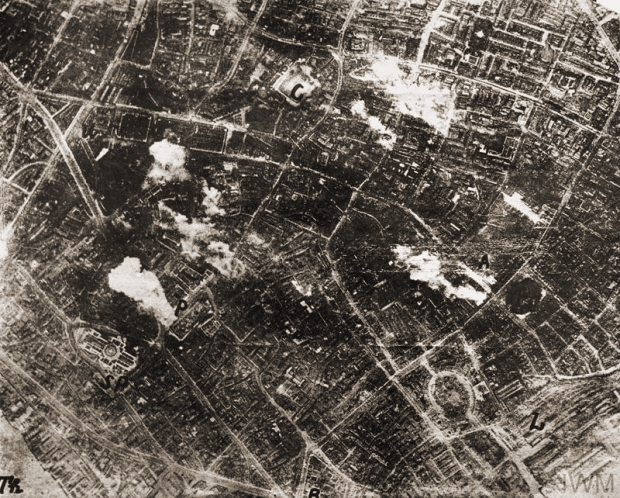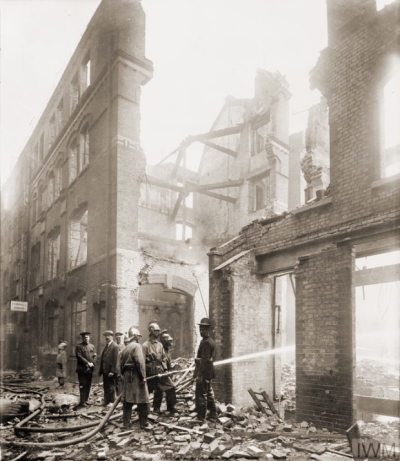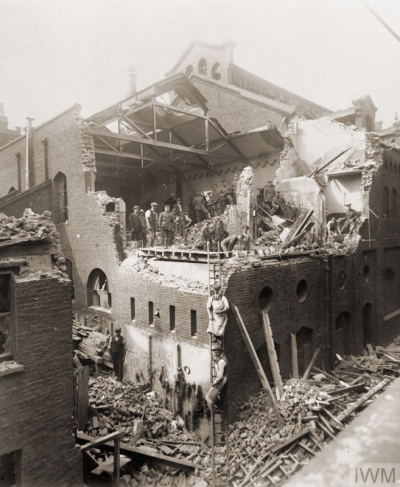The Flare Path: 100 Years Ago Today...
WWI history with a dash of WOFF
...London was reeling. For the second time in a month a skein of bone-white, Iron Cross-emblazoned bombers had overflown the British capital leaving death and destruction in its wake. For the second time in a month the throbbing heart of the most powerful empire on Earth had been scourged in broad daylight by a band of leisurely marauders apparently impervious to flak and fighters. In today's Flare Path, the story of a raid that woke up Whitehall, persuaded King George V to change his name, and almost killed one of England's most famous air aces.
By 1917 improvements in aircraft performance and ammunition design, together with the steady spread of searchlight-supported AA sites, had taken the sting out of the Zeppelin menace. If bad weather or engine problems didn't disrupt the nefarious nocturnal activities of the giant German "baby killers” then there was a fair chance that 'Archie' or RFC and RNAS pilots would. Londoners had enjoyed nine months of relative calm when, on June 25, they encountered Kampfgeschwader der Obersten Heeresleitung 3 – the England Squadron – for the first time.
Flying Gotha G.IVs – a new type of large biplane crewed by three men and powered by two 260 hp Mercedes 'pusher' engines - from bases in East Flanders, Belgium the well-trained squadron approached its goal from the north-east using the Thames and Epping Forest as navigation aids.
Three miles high in a cloudless sky, the diamond of 22 bombers drew the gaze of thousands as it droned towards the City. Until the gun batteries began stirring, most assumed they were watching friendly machines; the idea that a mass of hostile aircraft could reach the capital without being torn to shreds by Home Defence fighters was too preposterous to contemplate.
The novelty of the spectacle and the shambolic nature of the air-raid precautions of the time meant many of the 162 people killed during the raid (432 were injured) were slain in streets and other open spaces. Writer and soldier Siegfried Sassoon was at the Great Eastern Railway's terminus when it received its trio of bombs.
“At Liverpool Street there had occurred what, under normal conditions, would be described as an appalling catastrophe. Bombs had been dropped on the station and one of them had hit the front carriage of the noon express to Cambridge. Horrified travellers were hurrying away. The hands of the clock indicated 11.50; but railway-time had been interrupted; for once in its career, the imperative clock was a passive spectator. While I stood wondering what to do, a luggage trolley was trundled past me; on it lay an elderly man, shabbily dressed, and apparently dead. The sight of blood caused me to feel quite queer. This sort of danger seemed to demand a quality of courage dissimilar to front line fortitude. In a trench one was acclimatized to the notion of being exterminated and there was a sense of organized retaliation. But here one was helpless; an invisible enemy sent destruction spinning down from a fine weather sky; poor old men bought a railway ticket and were trundled away again dead on a barrow; wounded women lay about in the station groaning.”
Just outside the station a packed omnibus was torn apart... three miles to the east 18 children died when their school took a direct hit... in random spots right across the East End explosions murdered, mutilated, and left indelible mental scars.
Of the handful of British fighters that managed to intercept the formation on its way back to Belgium, none were able to penetrate the intimidating web of defensive MG fire and achieve a kill. On their return a couple of Gothas crash-landed, but understandably these losses failed to dampen the euphoria in the German press. 'Fortress London' had been breached, Britain's air forces utterly humiliated. While Holtzendorff's U-boats starved the British bulldog into submission from the sea, Brandenburg's unstoppable war eagles would tear at its vitals and sap its will to fight from the air!
In Britain the calls for root-and-branch defensive reorganisation and swingeing reprisal raids weren't slow in coming. The Cabinet wanted to recall two squadrons of modern fighters from the Western Front immediately. Informed by Sir Douglas Haig that such a step would jeopardise an imminent offensive, they eventually made do with just one, and that only for a week or two - long enough, it was believed, for the Boche to be taught a lesson.
Cecil 'Sagittarius Rising' Lewis' squadron, was chosen.
“Agitation in the press! Scandalous neglect of the defence of dear old England! Questions in the House! Panic among the politicians! Lloyd George acting quickly! Result: a crack squadron to be recalled for the defence of London, twelve elated pilots of 56 Squadron packing a week's kit into our cockpits. God bless the good old Gotha!”
Aware that defences were being bolstered, the England Geschwader sensibly bided its time. On the morning of July 7 as 56 Squadron flew back to Flanders, the Gothas headed west, London-bound once again.
Faster and higher thanks to lighter bomb loads and led by a new commander (Brandenburg had been badly wounded in an Albatross crash while returning from Berlin with the Blue Max that was his reward for the June 25 raid) the 22-strong throng was spotted by the crew of the Kentish Knock lightship at 09.24. Ten minutes later RNAS fighters based near the coast were in the air, beginning laborious 12000ft climbs.
Few of the 80-odd British pilots that attempted interceptions that day would have encountered a Gotha before or known much about their defensive capabilities. Of the handful that managed to engineer meetings with the relatively fast Luftstreitkräfte machines, many, like Captain John Palethorpe, attacked from below only to discover that a G.IV's ventral Parabellum LMG 14 machine gun was perfectly positioned to deal with such approaches (Palethorpe eventually landed at Rochford with a bullet in his hip and a steed riddled with holes).
The anti-aircraft batteries that hailed the raiders as they made their way along the Thames Estuary also struggled.
Guided by thirty-year old Hauptmann Rudolf Kleine, a commander every bit as calm, collected and skilful as Brandenburg, at times the stepped formation's component flights fluidly shifted position to bamboozle British flak flingers.
As on June 25, the Gothas reached the capital's north-eastern suburbs unscathed and apparently unruffled. As on June 25, those suburbs were dotted with upturned faces and undisturbed by sirens.
Tottenham, Leytonstone, Stoke Newington, Islington, Clerkenwell... the “flight of swallows” made for the heart of the City. One bomb devastated the Post Office's Central Telegraph Office in St Martin's-le-Grand, a stone's throw from St Paul's Cathedral. Another fell amongst carriers at Tower Hill filling gutters with blood and igniting a hogshead of whisky. By the time people realised that the heavenly visitors were as friendly as H. G. Wells' Martians it was often too late.
Abandoned in the frantic rush for doorways and Tube station maws, horses were caught in numerous blasts. Neil Hanson's The First Blitz, one of the books that inspired this piece, describes many harrowing scenes of people maimed or obliterated on 7/7/1917, but the brief description of a fireman euthanizing a badly wounded horse with his axe, must rank amongst its most grimly memorable.
Unloading their last bombs over the warehouse-crowded Isle of Dogs, the unburdened England Squadron turned east leaving 57 dead and hundreds of wounded behind them. A menagerie of Home Defence aircraft harried them between the capital and the Belgian coast, but as in the first raid, the relatively swift matrix of bombers had little to fear from dated British fighters mounting courageous solo attacks.
At least one RFC pilot paid for his persistence with his life (Hit “across the eyes”, Lieutenant W.G. Salmon of 63 Squadron endeavored to get home but lost control as he came into land). The other British airmen killed during the pursuit - Second Lieutenant John Young and his companion Air Mechanic C. C. Taylor - were probably victims of 'friendly' AA fire.
Not that they knew it, but the returning Gothas came within a whisker of ending the career of one of Britain's most efficient Fokker finishers.
From Flying Fury by James McCudden VC:
“The warning came through at about 10 a.m., and I at once left the ground and climbed away towards the south of the Thames. When over Canterbury I could see a certain signal out on Bekesbourne aerodrome which told me that the Huns were in the London area. I climbed steadily and made up my mind that I was not going to miss them this time. I arrived over Southend at 16,000 ft. and then flew westwards along the north bank of the river.
Very soon I saw the welcome cloud of British Archie bursting over Tilbury and I could discern a lot of big machines in good formation flying east. I had plenty of time to determine what to do, and also a lot of height to spare. As soon as all the formation had passed by, I dived on the rearmost machine and fired a drum at close range. In diving I came rather too near the top plane of the Gotha and had to level out so violently to avoid running into him that the downward pressure of my weight as I pulled my joystick back was so great that my seat-bearers broke, and I was glad it wasn't my wings.
I remained above again and now thought of a different way to attack the rearmost Gotha. I put on a new drum and dived from the Hun's right rear to within 300 ft., when I suddenly swerved, and changing over to his left rear, closed to 50 yards and finished my drum before the enemy gunner could swing his gun from the side at which I first dived. I zoomed away, but the Hun still appeared to be O.K.
Then I put on my third and last drum and made up my mind that I should have a good go at getting him. I repeated the manoeuvre of changing from one side to the other and had the satisfaction of seeing my tracer bullets strike all about his fuselage and wings, but beyond causing the Gotha to push his nose down a little, it had not the desired effect. I was very disappointed, as I had used up all my ammunition and the Huns were only just over Southend.
It was very silly of me only to carry three single drums of ammunition when I could easily have carried a dozen without affecting the climb and speed of my machine, for I now had nothing else to do except to fly alongside the Huns and make faces at them.
The rearmost Hun had the letters K.A. on the side of his fuselage and another one had S. on his. I flew abreast of the last Gotha at about 200 yards range, in such a position that the rear gunner could not fire at me, owing to his wings and struts being in the way. My idea in flying alongside was to try to monopolise the Hun gunner's attention so that some of our other machines, of which there were a lot in attendance, could fly up behind the Hun unperceived and shoot at him whilest he was looking at me. However, my comrades had their own attractions , and so I escorted this rear Gotha for 25 minutes at 200 yards range and had not a shot to fire at him.
My feelings can be much better imagined than described, and owing to my carelessness the Hun finally put a good burst of bullets through my machine, one of which went bang though my wind-screen, much to my consternation. I now got rather fed up up with acting as ground-bait for other people, who apparently had no idea of appreciating my generous intentions, so I flew a little farther away from the K.A. Gotha, whose gunner I decided was a very nasty man.”
McCudden worked off his frustration by “doing a short spin for the amusement of the Boche” before heading back to Kent. In scenes reminiscent of the anti-Dutch riots that followed the Great Fire of London, some angry East Enders chose to channel theirs into mob violence.
Acknowledging the anti-German feelings raised to fever pitch by the summer raids, on July 17, King George V made the sage decision to change the name of his familial house from the embarrassingly topical House of Saxe-Coburg and Gotha, to the unequivocally British House of Windsor.
The Cabinet too, recognised that the time for half-measures was past. Realising that further humiliation at the hands of the Deutsche Luftstreitkräfte would probably bring down his coalition goverment, Lloyd George sprang into action. 46 Squadron with its pacy Pups was brought home to Hornchurch. New systems for warning civilians of approaching air raids were devised and implemented. A committee headed by Jan Smuts produced an amazingly prompt report that formed the basis for a coordinated air defence network that survived little-changed until WW2 when it helped the RAF prevail during the Battle of Britain.
Faced by a better organised and equipped foe, the outfit that had proved the viability of daylight strategic bombing eventually switched to night ops. Their battle fleets bolstered by new varieties of aerial colossi, and their navigational accuracy seriously compromised by darkness, they continued to crater England and kill Englanders off-and-on almost until the end of the war. Compared to the slaughter on the Western Front their victims were few, but their deeds were influential. The notion that “the bomber will always get through” surely owed something to the sight of those serried ranks of air hawks 'hovering' over London in 1917.
* * *
























